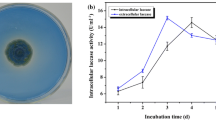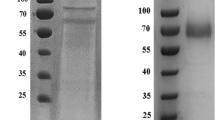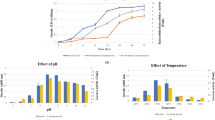Abstract
The aim of this study is to determine the key laccase-encoding gene in the life cycle of Morchella importuna SCYDJ1-A1, and to characterize the biochemical properties of the laccase. Two laccase-like multicopper oxidase (LMCO) genes were identified in the genome of M. importuna SCYDJ1-A1 as putative laccase-encoding genes. The two genes, belonging to Auxiliary Activity family 1 subfamily 3, were named as MiLacA and MiLacB. Phylogenetic analysis of deduced amino acid sequences showed that MiLacA is closest to a LMCO of M. importuna 22J1, while MiLacB had low similarity with known Morchella LMCOs. Real-time quantitative PCR results showed that MiLacA was expressed at much higher levels than MiLacB throughout the entire course of artificial cultivation. MiLacA was overexpressed in Pichia pastoris as a recombinant protein. Biochemical characterization of the purified enzyme showed that MiLacA simultaneously possessed laccase and polyphenol-oxidase activities. MiLacA could be strongly inhibited by Fe2+, which is unusual. The optimum pH was four and optimum temperature was 60 °C. The enzyme retained over 74% of the laccase activity after 16-h incubation at 60 °C, which means that its thermostability is at the forefront among the currently known laccases. Our findings may help to elucidate how the laccase of M. importuna is involved in decaying lignin in plant litter, and could also provide a candidate thermostable laccase for potential industrial application.






Similar content being viewed by others
References
Alfaro M, Castanera R, Lavín JL, Grigoriev IV, Oguiza JA, Ramírez L, Pisabarro AG (2016) Comparative and transcriptional analysis of the predicted secretome in the lignocellulose-degrading basidiomycete fungus Pleurotus ostreatus. Environ Microbiol 18:4710–4726
Baldrian P (2006) Fungal laccases—occurrence and properties. FEMS Microbiol Rev 30:215–242
Bánfi R, Pohner Z, Kovács J, Luzics S, Nagy A, Dudás M, Tanos P, Márialigeti K, Vajna B (2015) Characterisation of the large-scale production process of oyster mushroom (Pleurotus ostreatus) with the analysis of succession and spatial heterogeneity of lignocellulolytic enzyme activities. Fung Biol 119:1354–1363
Bo W, Yan Y, Xu J, Fu X, Han H, Gao J, Li Z, Wang L, Tian Y, Peng R, Yao Q (2018) Heterologous expression and characterization of a laccase from Laccaria bicolor in Pichia pastoris and Arabidopsis thaliana. J Microbiol Biotechnol 28:2057–2063
Bradford MM (1976) A rapid and sensitive method for the quantization of microgram quantities of protein utilizing the principle of protein-dye binding. Anal Biochem 72:248–254
Chefetz B, Chen Y, Hadar Y (1998) Purification and characterization of laccase from Chaetomium thermophilium and its role in humification. Appl Environ Microbiol 64:3175–3179
Christopher LP, Yao B, Ji Y (2014) Lignin biodegradation with laccase-mediator systems. Front Energ Res 2:12
Doré J, Perraud M, Dieryckx C, Kohler A, Morin E, Henrissat B, Lindquist E, Zimmermann SD, Girard V, Kuo A, Grigoriev IV, Martin F, Marmeisse R, Gay G (2015) Comparative genomics, proteomics and transcriptomics give new insight into the exoproteome of the basidiomycete Hebeloma cylindrosporum and its involvement in ectomycorrhizal symbiosis. New Phytol 208:1169–1187
Eichlerová I, Šnajdr J, Baldrian P (2012) Laccase activity in soils: considerations for the measurement of enzyme activity. Chemosphere 88:1154–1160
Endo K, Hayashi Y, Hibi T, Hosono K, Beppu T, Ueda K (2003) Enzymological characterization of EpoA, a laccase-like phenol oxidase produced by Streptomyces griseus. J Biochem 133:671–677
Hildén K, Hakala TK, Maijala P, Lundell TK, Hatakka A (2007) Novel thermotolerant laccases produced by the white-rot fungus Physisporinus rivulosus. Appl Microbiol Biotechnol 77:301–309
Hildén K, Hakala TK, Lundell T (2009) Thermotolerant and thermostable laccases. Biotechnol Lett 31:1117
Hobbie EA, Rice SF, Weber NS, Smith JE (2016) Isotopic evidence indicates saprotrophy in post-fire Morchella in Oregon and Alaska. Mycologia 108:638–645
Jia D, Wang B, Li X, Peng W, Zhou J, Tan H, Tang J, Huang Z, Tan W, Gan B, Yang Z, Zhao J (2017) Proteomic analysis revealed the fruiting-body protein profile of Auricularia polytricha. Curr Microbiol 74:943–951
Kanwal HK, Reddy MS (2014) Influence of sclerotia formation on ligninolytic enzyme production in Morchella crassipes. J Basic Microbiol 54:S63–S69
Katoh K, Toh H (2008) Recent developments in the MAFFT multiple sequence alignment program. Brief Bioinform 9:286–298
Kelley LA, Mezulis S, Yates CM, Wass MN, Sternberg MJE (2015) The Phyre2 web portal for protein modeling, prediction and analysis. Nat Protoc 10:845–858
Kellner H, Luis P, Buscot F (2007) Diversity of laccase-like multicopper oxidase genes in Morchellaceae: identification of genes potentially involved in extracellular activities related to plant litter decay. FEMS Microbiol Ecol 61:153–163
Kiiskinen L-L, Kruus K, Bailey M, Ylösmäki E, Siika-aho M, Saloheimo M (2004) Expression of Melanocarpus albomyces laccase in Trichoderma reesei and characterization of the purified enzyme. Microbiology 150:3065–3074
Ling Z-R, Wang S-S, Zhu M-J, Ning Y-J, Wang S-N, Li B, Yang A-Z, Zhang G-Q, Zhao X-M (2015) An extracellular laccase with potent dye decolorizing ability from white rot fungus Trametes sp. LAC-01. Int J Biol Macromol 81:785–793
Liu Y, Huang L, Guo W, Jia L, Fu Y, Gui S, Lu F (2017) Cloning, expression, and characterization of a thermostable and pH-stable laccase from Klebsiella pneumoniae and its application to dye decolorization. Process Biochem 53:125–134
Liu Q, Ma H, Zhang Y, Dong C (2018) Artificial cultivation of true morels: current state, issues and perspectives. Crit Rev Biotechnol 38:259–271
Loizides M (2017) Morels: the story so far. Field Mycol 18:42–53
Lyashenko AV, Bento I, Zaitsev VN, Zhukhlistova NE, Zhukova YN, Gabdoulkhakov AG, Morgunova EY, Voelter W, Kachalova GS, Stepanova EV, OgV Koroleva, Lamzin VS, Tishkov VI, Betzel C, Lindley PF, AbM Mikhailov (2006) X-ray structural studies of the fungal laccase from Cerrena maxima. J Biol Inorgan Chem 11:963–973
Martínez ÁT, Speranza M, Ruiz-Dueñas FJ, Ferreira P, Camarero S, Guillén F, Martínez MJ, Gutiérrez Suárez A, Río Andrade JCd (2005) Biodegradation of lignocellulosics: microbial, chemical, and enzymatic aspects of the fungal attack of lignin. Int Microbiol 8:195–204
Mate DM, Alcalde M (2017) Laccase: a multi-purpose biocatalyst at the forefront of biotechnology. Microb Biotechnol 10:1457–1467
Michniewicz A, Ullrich R, Ledakowicz S, Hofrichter M (2006) The white-rot fungus Cerrena unicolor strain 137 produces two laccase isoforms with different physico-chemical and catalytic properties. Appl Microbiol Biotechnol 69:682–688
Peng W, Chen Y, Tan H, Tang J, Gan B (2015) Artificial cultivation of morels is blooming in Sichuan. In: bulletin for 8th international conference on mushroom biology and mushroom products 13
Peng W, Tang J, He X, Chen Y, Tan H (2016) Status analysis of morel artificial cultivation in Sichuan. Edible Med Mushrooms 24:145–150
Petersen TN, Brunak S, von Heijne G, Nielsen H (2011) SignalP 4.0: discriminating signal peptides from transmembrane regions. Nat Meth 8:785–786
Pettersen EF, Goddard TD, Huang CC, Couch GS, Greenblatt DM, Meng EC, Ferrin TE (2004) UCSF chimera—a visualization system for exploratory research and analysis. J Comput Chem 25:1605–1612
Pinto PA, Dias AA, Fraga I, Marques G, Rodrigues MAM, Colaço J, Sampaio A, Bezerra RMF (2012) Influence of ligninolytic enzymes on straw saccharification during fungal pretreatment. Bioresour Technol 111:261–267
Shirkavand E, Baroutian S, Gapes DJ, Young BR (2016) Combination of fungal and physicochemical processes for lignocellulosic biomass pretreatment—a review. Renew Sust Energ Rev 54:217–234
Tan H, Miao R, Liu T, Cao X, Wu X, Xie L, Huang Z, Peng W, Gan B (2016a) Enhancing the thermal resistance of a novel Acidobacteria-derived phytase by engineering of disulfide bridges. J Microbiol Biotechnol 26:1717–1722
Tan H, Wu X, Xie L, Huang Z, Peng W, Gan B (2016b) Identification and characterization of a mesophilic phytase highly resilient to high-temperatures from a fungus-garden associated metagenome. Appl Microbiol Biotechnol 100:2225–2241
Tan H, Wu X, Xie L, Huang Z, Peng W, Gan B (2016c) A novel phytase derived from an acidic peat-soil microbiome showing high stability under acidic plus pepsin conditions. J Mol Microbiol Biotechnol 26:291–301
Tan H, Tang J, Li X, Liu T, Miao R, Huang Z, Wang Y, Gan B, Peng W (2017) Biochemical characterization of a psychrophilic phytase from an artificially cultivable morel Morchella importuna. J Microbiol Biotechnol 27:2180–2189
Tan H, Miao R, Liu T, Yang L, Yang Y, Chen C, Lei J, Li Y, He J, Sun Q, Peng W, Gan B, Huang Z (2018) A bifunctional cellulase–xylanase of a new Chryseobacterium strain isolated from the dung of a straw-fed cattle. Microb Biotechnol 11:381–398
Theuerl S, Buscot F (2010) Laccases: toward disentangling their diversity and functions in relation to soil organic matter cycling. Biol Fertil Soils 46:215–225
Thevenot M, Dignac MF, Rumpel C (2010) Fate of lignins in soils: a review. Soil Biol Biochem 42:1200–1211
Xie C, Luo W, Li Z, Yan L, Zhu Z, Wang J, Hu Z, Peng Y (2016) Secretome analysis of Pleurotus eryngii reveals enzymatic composition for ramie stalk degradation. Electrophoresis 37:310–320
Zavarzina AG, Leontievsky AA, Golovleva LA, Trofimov SY (2004) Biotransformation of soil humic acids by blue laccase of Panus tigrinus 8/18: an in vitro study. Soil Biol Biochem 36:359–369
Zhang G-Q, Chen Q-J, Wang H-X, Ng TB (2013) A laccase with inhibitory activity against HIV-1 reverse transcriptase from the mycorrhizal fungus Lepiota ventriosospora. J Mol Cat B: Enz 85–86:31–36
Acknowledgements
This research was supported by the Sichuan Science and Technology Program (Applied Fundamental Research Project, 2018JY0637), Innovative Improvement Projects of Sichuan Province (2016ZYPZ-028, 2016LWJJ-007), and the Special Fund for Agro-scientific Research in the Public Interest (201503137).
Author information
Authors and Affiliations
Corresponding authors
Ethics declarations
Conflict of interest
The authors declare no conflict of interest.
Electronic supplementary material
Below is the link to the electronic supplementary material.
Rights and permissions
About this article
Cite this article
Zhang, Q., Miao, R., Liu, T. et al. Biochemical characterization of a key laccase-like multicopper oxidase of artificially cultivable Morchella importuna provides insights into plant-litter decomposition. 3 Biotech 9, 171 (2019). https://doi.org/10.1007/s13205-019-1688-6
Received:
Accepted:
Published:
DOI: https://doi.org/10.1007/s13205-019-1688-6




